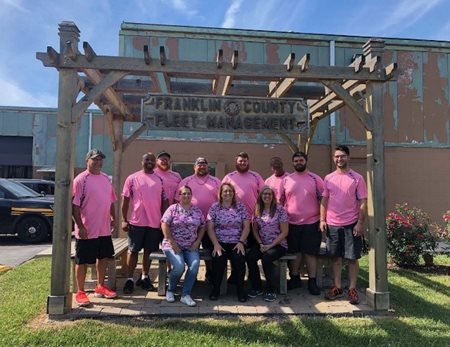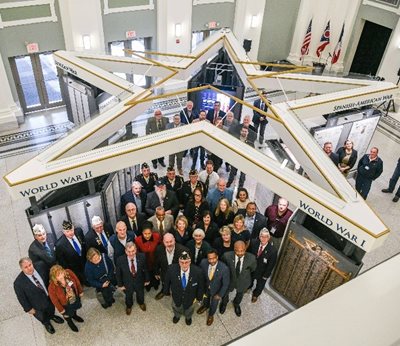A WELCOME FROM COUNTY COMMISSIONER KEVIN L. BOYCE
Hello and welcome to the November edition of the Commissioner Connection newsletter.
Fall is here, and there’s so much going on at the Board of Commissioners that it seems like the summer went by in a flash.

This summer, my colleagues and I attended the National Association of Counties annual conference, where we learned about some of the best and most innovative ways that counties across the country are serving their constituents, and shared some of the exciting things going on in Central Ohio. A highlight of the trip was a tour of the Virgin Hyperloop One facility. Our partners at the Mid-Ohio Regional Planning Commission are heading a
Rapid Speed Transportation Initiative to explore intercity routes that could use technology like the Hyperloop to connect Columbus with nearby cities for very high speed travel. Imagine getting to Chicago or Pittsburg in half an hour!
I was also named to a group of leaders participating in a new NACo initiative funded by the Bill and Melinda Gates Foundation called the Economic Mobility Leadership Network. We’ve visited several counties around the nation to explore how they have been successful in promoting economic mobility among their residents in order to develop local solutions that can help other communities replicate their results.
Something that dovetails nicely with that work, and which I am especially proud of is the release of the Board of Commissioners’
Rise Together Blueprint for Reducing Poverty in Franklin County, and our new investments in affordable housing. Rise Together was the result of a months-long project to analyze the causes of poverty that are unique to Central Ohio and the resources that are available in our community, and to create a comprehensive plan to more effectively bring those resources to bear on the problem with a community-wide, systematic approach.
In August, the board was also able to add to the nearly $17 million that the county already invests in affordable housing each year with
an additional $6.5 million annually. Read on, and you can learn all about the Rise Together Blueprint and our new Affordable Housing investments later in this issue of Commissioner Connection.
Also in this month’s edition of the newsletter, you can look forward to learning about a community partner that is providing much needed care and medicine to some of the most vulnerable in our community, and about a small but vital county agency that goes above and beyond the call of duty for our residents every day.
Thank you again for taking the time to read the newsletter, and please don’t hesitate to
reach out to my office if you have any questions or concerns that I can help with. Be sure also to keep up with everything your county commissioners are up to by following the board on
Facebook and
Twitter as we continue working to make Franklin County a great place to build a business or raise a family.

Kevin L. Boyce
Franklin County Commissioner
COMMISSIONERS TAKE ON THE CHALLENGE OF POVERTY
 In the fall of 2018, the commissioners began a new initiative to explore the causes of poverty that are particular to Central Ohio and the resources that are available locally, and to put together a comprehensive plan to begin to address poverty in a systematic way, marshalling all of the community’s resources to make life better for all Franklin County families.
In the fall of 2018, the commissioners began a new initiative to explore the causes of poverty that are particular to Central Ohio and the resources that are available locally, and to put together a comprehensive plan to begin to address poverty in a systematic way, marshalling all of the community’s resources to make life better for all Franklin County families.
To begin, the commissioners hired a consultant to help lead the effort, then assembled a steering committee of local non-profit, government, business, community, and religious leaders, many of whom have experienced poverty in their own lives. They led dozens of meetings with hundreds of local residents who are struggling to get ahead, and engaged the Ohio State University Kirwan Institute to collect and analyze data. The result is the Franklin County Rise Together Blueprint, which includes 120 goals and action steps to begin to address poverty more effectively.
The first thing that became apparent through this process is that the issue of poverty cannot be separated from issues of race, so the commissioners have begun to initiate a community conversation on race, beginning with racial equity training for county staff and key partners in the non-profit and business communities. They’ve also undertaken a series of immediate action steps that they’ve identified as things they can do right away to start to move the needle on poverty, including new community grants, funding the Future Cities program, expanding the Building Futures job-training initiative, and raising their own employees’ minimum wage to at least $15 per hour.
The next steps involve the creation of an Innovation Center to be housed at the Columbus Partnership and led by a leadership committee co-chaired by Trudy Bartley of The Ohio State University and Matt Habash of the Mid-Ohio Foodbank. The Innovation Center will begin immediately to take on three of the goals identified in the blueprint and to study the big idea of piloting universal childcare and early childhood education for Franklin County residents. In 12 to 18 months, the commissioners envision the Innovation Center spinning off into a stand-alone organization to which they have committed up to $2.5 million in annual funding as well as to soliciting a similar amount from other sources.
The commissioners know that they’ve only just begun what is to be a long and difficult process, but they also understand that while our community is thriving in many ways, it cannot be successful until every family has an opportunity to get ahead.
To download a copy of the Rise Together Blueprint, visit https://commissioners.franklincountyohio.gov/poverty.
ECONOMIC DEVELOPMENT PLANNING INCLUDES HISTORIC NEW INVESTMENT IN AFFORDABLE HOUSING

The Central Ohio economy has grown faster in the past ten years than during any other decade in its history, and approximately 200,000 new residents have come to call our region home in that time. Franklin County is now the largest and fastest growing large county in Ohio. Ours is also the fastest growing region in the Midwest, and for good reason, as it’s one of the best places in the nation for young families, fashion, food, and startup companies. All of that success, however comes with tradeoffs, including a roaring real estate market that can make it very hard for working families to find housing that they can afford. Worse still, finding affordable housing in desirable neighborhoods, near job centers and good schools, and on public transportation lines can feel nearly impossible.
For years, Franklin County has invested millions and millions of dollars each year in affordable housing efforts, including with the Community Shelter Board and the Affordable Housing Trust. The Mid-Ohio Regional Planning Commission estimates that as many as one million more new residents will be coming to Central Ohio in the next 30 years, however, so the problem and need for affordable housing isn’t going away anytime soon.
So, when the commissioner’s Economic Development and Planning department began creating a new five-year strategic plan earlier this year, the commissioners asked that it include plans for how the county can continue and expand its support for affordable housing. The result is comprehensive, and includes a new investment of an additional $65 million to build more than 2,000 new affordable housing units over the next ten years.
The new initiative includes yearly investment of $4.125 million for a County Housing Magnet Fund to help fund affordable housing development near employment centers and public transportation, and $2.375 million to the new Central Ohio Community Land Trust, which will be used to acquire and hold land in developing areas to ensure that its housing remains affordable for the long-term. In all, the approximately $6.5 million annual investment is expected result in 205 new affordable housing units each year.
In August, the commissioners
voted to accept the recommendations and begin to implement the new plan. To download a copy of the full Economic Development and Planning Five-Year plan, and the Affordable Housing framework, visit:
https://development.franklincountyohio.gov/edsp.
COMMISSIONERS’ FLEET MANAGEMENT TEAM KEEPS FRANKLIN COUNTY ON THE ROAD TO SUCCESS
 If you see a Franklin County vehicle on the road, and there are more than 500 of them, you can be sure that that vehicle is well taken care of thanks to the professionals at the commissioners’ Franklin County Fleet Management agency. This department procures, maintains, repairs, and eventually disposes of all of the county’s vehicles, including some pretty unusual ones at a 17,000 square-foot facility east of downtown. They’re a tight-knit team with long experience that does a lot with a little and their leader, Director Charlotte Ashcraft, isn’t even one of the longest-serving members of the group at 29 years. In that time, the size of the county fleet has more than doubled, but the Fleet Management team has only grown by one member to a total of 12. The team’s five mechanics have a combined 136 years of experience, however, so you know the county’s vehicles are in good hands.
If you see a Franklin County vehicle on the road, and there are more than 500 of them, you can be sure that that vehicle is well taken care of thanks to the professionals at the commissioners’ Franklin County Fleet Management agency. This department procures, maintains, repairs, and eventually disposes of all of the county’s vehicles, including some pretty unusual ones at a 17,000 square-foot facility east of downtown. They’re a tight-knit team with long experience that does a lot with a little and their leader, Director Charlotte Ashcraft, isn’t even one of the longest-serving members of the group at 29 years. In that time, the size of the county fleet has more than doubled, but the Fleet Management team has only grown by one member to a total of 12. The team’s five mechanics have a combined 136 years of experience, however, so you know the county’s vehicles are in good hands.
Thanks for taking the time to tell us a little about Fleet Management, Charlotte. Tell us what goes into taking care of the county’s vehicles.
First and foremost, I think of us as a customer service agency. We maintain vehicles for 56 county divisions, and always with an eye toward getting our county coworkers back on the road to do their jobs for our residents. I’m proud of our reputation for our customer focus, and for our team taking ownership of providing the highest quality work.
Your team is responsible for more than 500 vehicles in the county’s fleet. How many different kinds of vehicles is that, and how do you manage to service so many different types efficiently?
A lot of the vehicles we service are sheriff’s cruisers, but we also take care of vans, trucks, diesels, a couple 48 passenger busses, some alternative fuel vehicles, ATVs, generators, the SWAT and Bomb Squad trucks, golf carts, and boats and trailers. County employees fill a lot of different roles, and we support them all the best that we can.
What’s a typical day like at Fleet Management?
We start at 6:00 a.m., and you’d better have your coffee before you get here because mornings are busy. First thing most mornings, we have a ton of vehicles coming in for quick maintenance items so that they can get back on the road ASAP—things like tires, headlights, and batteries. Then in the afternoon, we schedule the biggest jobs: engines, transmissions, and body work that’s going to take a little longer. We do everything here except painting or other major body work, so there’s always plenty to do.
How about an atypical day? Any unusual service calls lately?
Well, it’s squirrel season right now, so that’s always a problem. Apparently, the insulation on the wires in many modern cars is soy-based, and it attracts rodents who like to chew on it. We always have a few cars come in this time of year that have had some wiring chewed through. We also had a team at the Democratic debate in Westerville a few weeks ago—we knew that the sheriff’s office would have a ton of their vehicles there for security, and figured that one way we could help out would be to have a mobile team on-site to handle any vehicle problems that come up. It’s the first time we’ve done that, but we want to go where our customers go, and it was good that we did because the team was able to quickly handle five vehicle issues that evening right on-site.
Are you able to track each county vehicle to see where it’s at any given time?
For the most part, the vehicles have a telematics system installed that provides a bunch of real-time data about the vehicle. We use it for diagnostics rather than to keep an eye on where the cars are. It tracks every system in the car and can send us alerts and diagnostics for every vehicle without them even coming into the shop. It lets us know which are big problems that need to be dealt with right away, and what can wait a little longer, tracks things like mileage and idle time so that we can be as efficient as possible, and helps us to schedule maintenance.
I understand that you sometimes donate vehicles that have reached the end of their useful life in Franklin County to other agencies or counties that don’t put as much wear and tear on their cars. How does that work?
A lot of our vehicles get used all day and all night all year ‘round, so a patrol cruiser for instance, might only last about three years here. After a year and a half, we shuffle them around to divisions that don’t drive quite as much, and that might let us extend that to five years. At that point, though, it costs as much to decommission them as the car itself is worth, so we’ll offer them to smaller county sheriff’s offices around the state for free. They may not drive nearly as much as us, so we can give it to them without having to decommission it as a police car, and they can get a few more years of useful life out of them. It’s a good way to be efficient, fiscally responsible, and environmentally friendly.
What else do you do to be fiscally and environmentally responsible?
Well, we’ve got 28 alternative fuel vehicles now, including two buses, and the county maintains 30 electric vehicle plug-in stations for both fleet vehicles and the public. We also do some less conventional things like heat our entire facility with a waste oil furnace. We go through more than 6,000 quarts of motor oil here each year, and then instead of paying somebody to recycle it for us as well as paying to heat the building, we’re able to use the oil to heat the building for free.
Your team is known for being pretty tight-knit, and for participating in a lot of office events and charitable fundraisers together. How are you able to foster that sense of teamwork and belonging?
I think it helps to be a small team, and it helps that we’re so proud of what we do helping our coworkers to be able to do their important jobs. We spend a lot of time in close proximity together, and it’s a lighthearted atmosphere. Really, I think it has more to do with having great people on the team than with any sort of management from above. We’re a family here, and we’ve all got each other’s backs.
What do you wish more of your colleagues at the county knew about Fleet Management?
Cars these days are a lot more difficult to work on than they used to be. The level of dedication, education, certification, and training that it takes to be good at it is far beyond what most people realize. I couldn’t be prouder of the team at Fleet, and I just hope everyone else also realizes how impressive they are.
Franklin County Fleet Management Fast Stats
- More than 500 vehicles in the fleet
- 282 sheriff’s office vehicles
- 14 pieces of special equipment like the bomb squad truck
- 28 alternative-fuel vehicles
- About 40 replacement vehicles purchased per year
- More than 5.5 million miles driven per year
- 1,100 oil changes per year
- 459 tires replaced last year
- 7,100 gallons of gasoline per week
MEET A COMMUNITY PARTNER; THE CHARITABLE PHARMACY OF CENTRAL OHIO
 The Franklin County Commissioners had one main goal in mind when creating their new Catalyst grants earlier this year: to provide seed funding for critical, community projects that can later become self-sustaining. Thirteen programs have been awarded grants so far. And though some of the funding is still being processed, these awards are already showing they will have a huge impact in Franklin County and beyond.
The Franklin County Commissioners had one main goal in mind when creating their new Catalyst grants earlier this year: to provide seed funding for critical, community projects that can later become self-sustaining. Thirteen programs have been awarded grants so far. And though some of the funding is still being processed, these awards are already showing they will have a huge impact in Franklin County and beyond.
The commissioners pledged $1.5 million in catalyst grants in 2019 to “to spark meaningful change for Franklin County residents in priority areas of Economic Security, Personal and Family Empowerment, Emerging and Basic Needs, and Community Enrichment.” It was one of the immediate actions they pledged as part of their new Rise Together Blueprint for addressing poverty.
One of the new grants is for $99,864 for the Charitable Pharmacy, which provides life-saving medication to Franklin County residents living below the poverty level who are uninsured or underinsured. These funds will help the existing pharmacy, which is housed in the Livingston United Methodist Church, and will help create a second satellite location in another high-poverty neighborhood.
The Charitable Pharmacy of Central Ohio is the only entity of its kind in Central Ohio, said Jenni Seifer, the pharmacy’s executive director. “This all would not be possible without the catalyst grant.”
In the past 10 years, the Charitable Pharmacy has provided about 450,000 prescriptions and has provided close to 40,000 pharmacy counseling sessions. Medical studies have shown this has reduced the agency’s clients’ number of emergency room visits and has reduced their overall health care costs, which are billed to Medicaid.
The second Charitable Pharmacy location is still in its planning stages, but is slated for the South Linden area.
 Charitable Pharmacy staff have also been helping to guide leaders in southeastern Ohio who want to replicate its success, and they have received calls from all over the country from other nonprofits who want to do the same.
Charitable Pharmacy staff have also been helping to guide leaders in southeastern Ohio who want to replicate its success, and they have received calls from all over the country from other nonprofits who want to do the same.
It is clear the Catalyst grant will do much more than help those locally, but also allow this model to be shared so others can be helped all over the country.
VETERANS PLAQUES BACK AT HOME IN MEMORIAL HALL
Earlier this month, the commissioners proudly opened a new display at County Memorial Hall of

plaques dedicated to Franklin County residents going back nearly 250 years. The plaques have been donated by various veterans groups through the years, and list the names of young men and women who have served our nation in conflicts from the Revolutionary to Vietnam Wars. Many of them were originally displayed at Memorial Hall for many years, while others were displayed at the former Veterans Memorial auditorium. When that building was torn down to make way for the new National Veterans Memorial and Museum, the plaques were stored for later display. Now, county residents can visit them any time the building is open in a new custom display at our county’s original memorial to veterans, Memorial Hall, at 280 E. Broad St.
Memorial Hall opened in 1906 in honor of soldiers and former soldiers, and for their entertainment and comradery. With a 4,000 seat auditorium, it was the second largest venue in the country, behind only Madison Square Garden, and it became the place for events in Central Ohio. Through the years, Memorial Hall hosted presidents Teddy Roosevelt, Woodrow Wilson, William Howard Taft, and Eleanor Roosevelt. It was also the sight of memorials for Warren G. Harding and Booker T. Washington, commemorations for the end of WWI, and housed a prohibition convention in the 1920s. It would later host concerts and professional sports, and from 1964 to 1999, served as host to COSI, Ohio’s Center of Science and Industry. The building was completely renovated following COSI moving to the old Central High School building on West Broad, and is now home to county offices such as the Veterans Service Commission, Franklin County Public Health, the Office on Aging, and Sanitary Engineering.
Restoring the plaques for a new exhibit was a lengthy project, requiring hand-work by skilled artisans. Officials then worked with a committee of veterans and interested residents who worked through every detail of the new display, which was unveiled at a dedication ceremony on November 4
th that included veterans of every branch of service, area historians, public officials, and the media, and which culminated with a lone bugler solemnly playing taps.